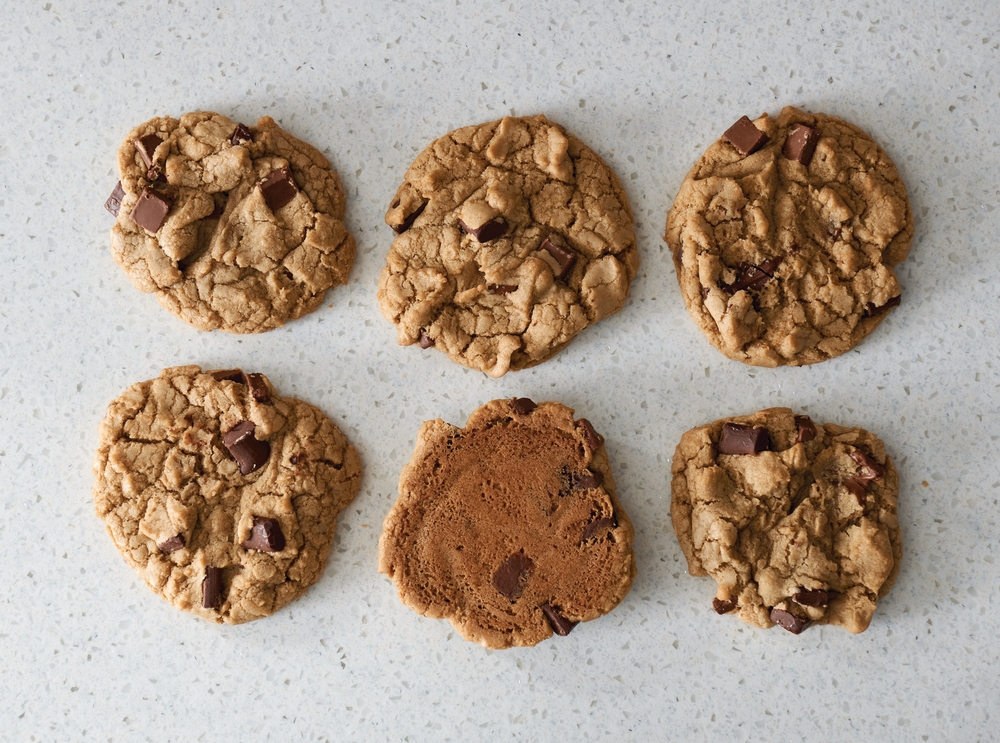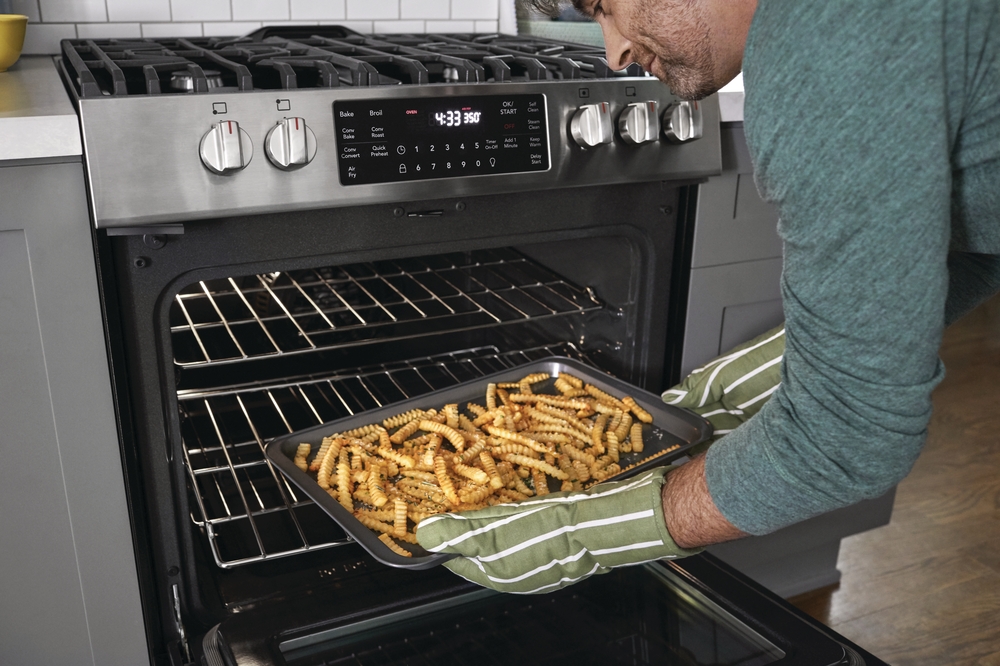The humble oven isn’t the same cooking appliance it was in the 1950s. Today’s shopper is looking for an oven designed around convenience and that gets dinner onto the table in fewer steps and with better results. Yet, while demand for faster, better, and more powerful ovens grows (especially now that we’re spending more time at home), many shoppers are still unsure which oven features provide that performance, exactly.
Arguably the most common example of all is convection baking. The feature might not be the newest addition on the block, but as manufacturers continue to make improvements to the design, convection remains one of the most useful oven features available to shoppers. Follow along to find out why.

Conventional and Convection: Which is Better?
For the everyday home cook, the conventional oven is an essential kitchen appliance. Whether it’s Thanksgiving turkey, holiday cookies, or your family’s Tuesday-night pot roast, traditional ovens offer a familiar experience that gets the job done.
But that doesn’t mean they’re flawless. In fact, conventional ovens have one major setback: They heat from bottom to top, which creates an imbalanced cooking environment where the top of the oven is always hotter than the bottom. Even worse, inconsistencies become even greater when sheet pans and cookware inhibit airflow (this is the main reason why recipes often call for rotating sheet pans halfway through).
Why Convection is an Upgrade
In a convection oven, heat receives an additional “boost” from the inclusion of a fan that helps distribute heat evenly throughout the entire chamber. This enhanced heat distribution improves the overall cooking experience by:
✓ Reducing cooking times
✓ Providing even cook temperatures
✓ Promoting better browning
✓ Allowing for multi-rack cooking without heat compromise
However, there is a slight learning curve when it comes to using a convection oven. First, airflow will be greater than on a conventional oven, since all heat distribution is done via thermal conduction. Secondly, the enhanced thermal transfer means foods heat up faster, resulting in quicker cooking times.

Some convection wall ovens come with a built-in conversion that adjusts cook temperatures and times automatically while other models don’t.
Fortunately, these simple convection conversion tips make using the feature easy:
- Lower temperature by 25 degrees
- Check for doneness 10 minutes before regular cook times
Conquer European True Convection
Standard convection cooking is a fantastic way to improve the results of oven-baked foods, but this heating system still only uses two heat sources: a heating coil on the bottom and a broiler above. The next level up is European convection baking, also known as true convection cooking. Unlike a basic convection oven, cooking appliances with true convection ovens use a third heating element installed with the fan at the back of the oven. With this extra heating source installed, air that’s been drawn in by the fan gets conditioned by the heating element before being evenly recycled back into the chamber.
On top of providing even better thermal conduction than standard convection heating, it also reduces flavor transfer between separate items baking at the same time. For instance, a delicate pastry and hearty pot roast can bake side-by-side with relatively little worry that one will taste like the other. That’s because, as the air is filtered through the heating element, it goes through a “purification” before returning into the oven as fresh, heated air.
- Heads-up: While European convection cooking is a popular oven feature, it can be hard to decipher which models come with the function and which ones don’t, from brand to brand. Make sure to chat with an expert from Grand Appliance and TV to determine standard convection versus true convection oven models.
Dual Convection Delivers Unbeatable Performance
Want even quicker bake times without compromising performance? Consider an oven with a dual convection system. Found on many premium brands, this advanced oven feature doubles up on heat circulation with two fans.
Since dual convection baking systems distribute heat throughout an oven faster than even European convection methods, this feature is a smart add-on to large-capacity ovens. Plus, with two times the coverage, dual convection systems virtually eliminate the possibility of any cold spots (or hot spots, for that matter), especially around the fan itself, which is often regarded as an oven’s “dead zone.”
Of course, this is a premium oven feature, so shoppers can expect to find this cooking method exclusively on professional brands. One of the best dual convection oven systems on the market is available on Wolf wall ovens with VertiCross convection technology.
VertiCross oven technology swaps the standard convection fan design for two columnar fans that deliver arguably the best heat distribution of any home oven on the market. And as a bonus, the relocation of the fans allows the oven wall to curve, providing even more oven capacity than standard convection ovens.
Air Fry vs. Convection
It’s hard to do a recipe search nowadays without stumbling across the growing list of meals that use the latest oven craze, Air Fry technology. We get it — foods that taste nearly like fried classics without the need for a countertop appliance or the mess and fat of oils? It’s a winning feature, which is why many shoppers might wonder whether buying an oven with an Air Fry setting is the same thing as convection.

It’s a fair question — the two oven settings do operate similarly — but the major difference lies in how each operates.
Put simply, a convection oven is designed for longer cooking times. That means users can use convection for something as quick as chocolate chip cookies or something that cooks as long as a roast.
The Air Fry setting on an oven, however, is designed to cook in a sprint over a shorter period of time. That’s achieved by using a super-powerful oven fan that circulate hot air at rates faster than a convection oven. But the difference is, once those high-heat settings are reached, the oven slowly cools for gradual cooking that prevents overcooking.
That speedy performance might sound enticing, but since the cool-down phase is less predictable than the even cooking process of convection oven, users shouldn’t expect to be able to convert recipes that cook for a long period time over to the Air Fry setting so easily.
Generally, here’s what shoppers should consider when it comes to a convection oven versus an oven with Air Fry:
- Frequency: For household that use the oven for everything from full-course meals to pastries, a convection oven is the more practical choice since cooking times and temperatures can easily be converted
- Menu items: For households that are big on using the oven for quick snacks, pub-style favorites, and the occasional oven-made dinner, an oven with an Air Fry bake setting can be a convenient upgrade from a traditional oven and a more affordable option than a convection oven
Related: Find out even more about Air Fry bake technology in our in-depth Air Fry buying guide.
Sweet, Delicious Savings
At Grand Appliance and TV, our wide catalog of reliable appliances, mattresses, and electronics from reputable brands are available to you at competitive prices and with unmatched service. With 25 locations throughout Wisconsin, Indiana, Illinois, and Iowa, there’s a showroom near you with in-stock appliances that match your design style and budget. Shop online or in-store today!
